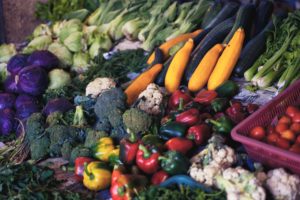5 Very Simple Ways to Save Money on Groceries
Back when I was first trying to organize our household finances, I realized that one of the easiest expenses to control and lower was our food cost. I knew going out to eat was very expensive, but soon recognized that even groceries eaten at home certainly added up as well.
I used to just walk up and down the grocery store aisles with no plan, and put any item I wanted into my cart. Then I’d be super shocked at the price at the register. Hello, McFly? Think!
Thankfully, I’ve come a long way in my grocery shopping techniques, and saved a bundle. I could really write a whole book on the subject, but here are my favorite and easiest tips so you can stop wondering why your grocery total is always so high.
5 Very Simple Ways to Save Money on Groceries
You May Also Like:
- The 70 Best Things to Buy at Aldi
- How I Saved Series – real life examples of my grocery shopping trips
- Where to Start When You’re Flat Broke
1. Buy what is on sale
Every week, your grocery store puts some items way on sale. These are called ‘loss leaders.’ The store probably makes very little profit, or takes a small loss, on these deeply discounted items. They know you’ll come into the store to buy the sale-priced chicken breasts, and then wander around filling your cart with a bunch of full-priced items. It sure works out well for them.
But what if you went to that store and bought those chicken breasts, but also mostly only bought other sale items? Every week there are a variety of fruits, vegetables, pantry staples, meat, dairy products, and cleaning items on sale. Instead of buying the same items every week, regardless of their price, you could buy the variety that is on sale that particular week.
Produce that’s in season will be much cheaper, and fresher and more nutritious, than when it’s not in season. You’ll have the opportunity to try more things and eat a better variety of foods as well.
Stock up when your favorite items are at a great price. If you love a certain cereal, don’t just go buy it once a week, every week. When it’s half price, stock up on 4-6 of them. Sale cycles usually run about 4-6 weeks, so you’ll be stocked up until the sale comes around again.
2. Don’t be afraid to try the generic brand
Lately I’ve heard multiple people say that they would never buy a generic version at the grocery store. Seriously, never? They’re not poisonous or anything. Store brand products are traditionally at least 33 percent cheaper than the brand name versions. That’s a hefty savings right there.
Companies that produce brand name products pay for fancier packaging and have high marketing costs. Store brand items aren’t more cheaply made, they’re simply cheaper to sell without the overhead. That huge savings gets passed along to you. And sometimes, the generic variety is actually still made by the brand name, just in different packaging.
Aldi is my absolute favorite place to try store brand items. I actually prefer the taste of many of their products over the name brands. And you don’t have to wait for a sale at Aldi because everything is already so affordable.
Related articles:
- 10 cheap and easy meals that anyone can make
- 5 easy meal planning strategies for beginners
- How to create your own meal planning kit (with free printables!)
3. Go to the store with a list (and stick to it!)
As the old adage goes, “failing to plan is planning to fail.” While there’s no such thing as ‘failing’ at the grocery store, shopping without a list or a plan will guarantee that you spend more money.
First, look through the sale ad, and write down the sale items that sound appealing. If you don’t receive the ad in the mail, they’re available on the stores’ websites. You don’t need a fancy meal plan, but at least outline in your mind (or on paper) what meals you can make out of that week’s sale items.
Peek into your refrigerator and pantry to see if you need some basic items like milk, eggs, or bread, and add those to your list. When you’re at the store, really compare the prices of these staple items. Try a different brand if it’s on sale, or the store brand if that’s the best value.
Also compare the ‘cost per unit.’ Divide the price of the item by how many units it has. A unit could be an ounce, or piece/count, etc., depending on what kind of product it is. The smaller box of cereal is most likely more expensive per ounce than a big box. It pays to do the math. Literally.
4. Add up your total as you shop
Since you have a list, this is easy. I write the cost of the item next to it on my list as I put it in my cart. I usually round the numbers, so I’m not trying to add $1.33 to $5.66 to $2.77. Every five items or so, add up what you have so far, and you won’t be so surprised at the register.
And if you do put items in your cart that aren’t on your list, make sure to write down the price of those as well. Every phone has a calculator built in, so keeping a running tally of your shopping trip shouldn’t be too difficult.
If you feel your total is getting higher than your budget allows, then it’s time to rethink some of the items in your cart. Or consider swapping some of them for less expensive alternatives.
5. Check out the clearance section
Most stores have a section or two where they house food that’s nearing its sell-by date. Kroger is one of my favorite places for this. I usually score inexpensive sandwich bread and buns and just put them in the freezer til we’re ready to eat them. I don’t notice any change in quality or texture at all after they’re thawed.
Most stores also have a rack of produce that isn’t as pretty. It’s still fine to eat, and you can score it at a deep discount. Plan to eat it soon or freeze it.
Target always has a variety of pantry items marked down on their end caps as well. The store can’t sell items that are past their sell-by date, but that doesn’t mean the item goes bad right then.
If it weirds you out to eat something that’s nearly ‘expired,’ just work it into your meal plan before that date. Dry goods certainly aren’t going to change consistency or spoil before then.
Try putting these simple practices into place on your next grocery trip. Consider comparing a few different stores’ sales ads to see which one has the best deals on the items you buy and shop there that week.
Make your list based on those sales, stick to that list, and keep a running tally of how much you’re spending as you shop. Don’t forget to consider the lower prices of store brands and check out the clearance racks.
Happy saving!
Want to share this post with friends and family, or save it to read again later? Click here to pin it on Pinterest.
You May Also Like:
- How to Get Started Meal Planning Today: 10 Super Easy Tricks
- How to Use a Master Grocery List (to save your time and sanity!)
- 10 Best Time-Saving Kitchen Gadgets (to make dinner time easier!)
- Create Quick & Cheap Meals with these 30 Pantry Staples
Don’t forget to check out the Resources Page for tons of other money saving resources!
What tricks do you use to save money on groceries?









Great idea, Sue! I hadn’t thought of that. I love that it involves giving back and helping others. I imagine that food pantries do sometimes have an excess of certain kinds of food. And it’s so cool that it’s helping you be more creative in the kitchen. Kind of like your own version of the show Chopped!